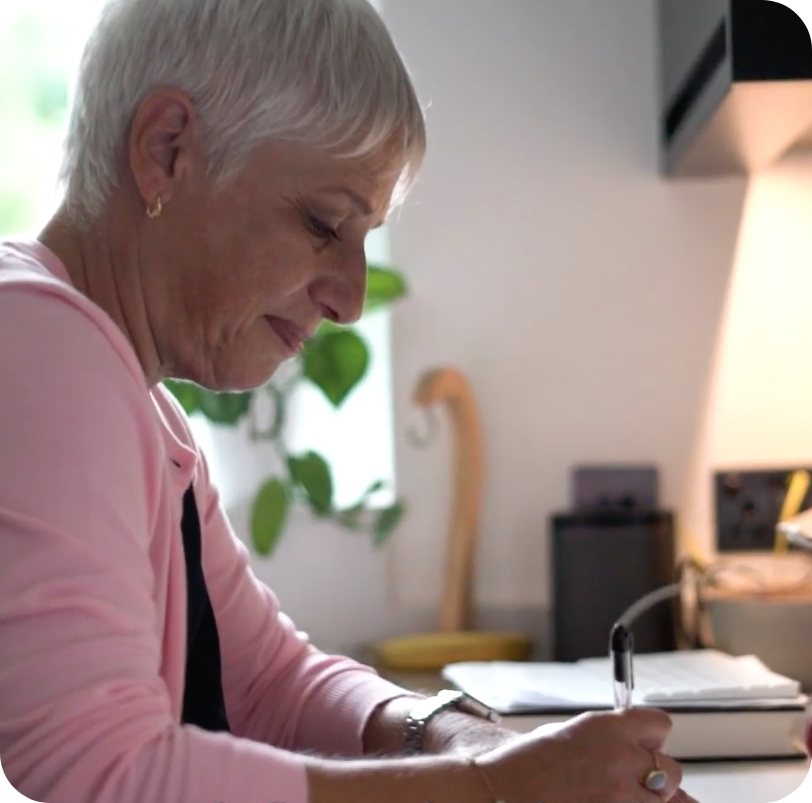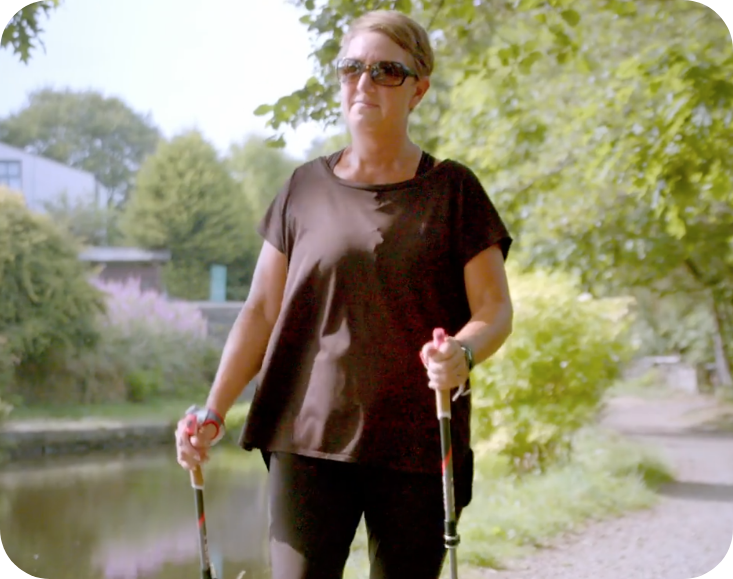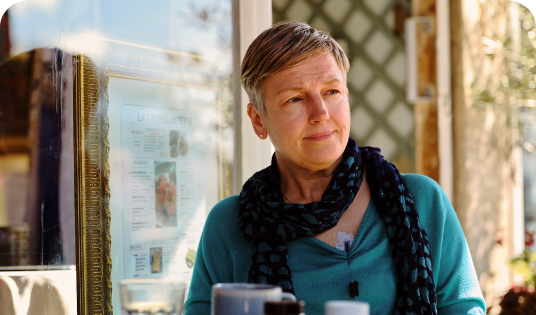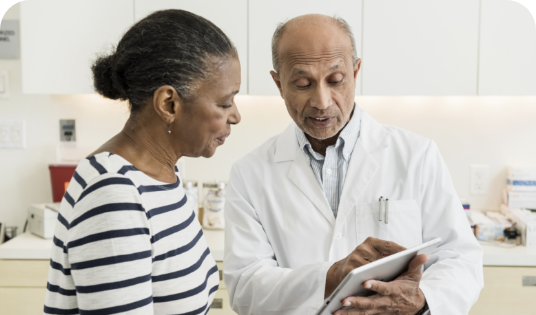Primary and secondary breast cancer defined
Helping you understand different stages of breast cancer
Moments That Count has been developed and funded by Novartis Pharmaceuticals UK Limited and is intended for a UK general public audience.
Helping you understand different stages of breast cancer
Most cancers start in one place. The place where a cancer starts is called the primary site. For example, if you have cancer that started and is localised in the breast, you have primary breast cancer.
When the cancer has spread to a new location, this location is known as the secondary site. So, if your breast cancer has spread to the lungs, your secondary site is the lung, and you have secondary breast cancer (also known as advanced, metastatic or stage 4 cancer).1
If you would like to learn more about the stages of breast cancer, click the button below to read our guide.

Cancers can spread around the body if left untreated, and in some cases, even if the patient is currently receiving a breast cancer treatment. When the cancer cells break away from where they first formed, they travel through the blood or lymphatic system (a network of tubes which collect fluid as part of the immune system) and reach the lymph nodes, forming new tumours in other parts of the body. This is known as metastasis.
The most common places primary cancer can spread to are:2


The Moments That Count ambassadors share their personal journeys in this intimate photo essay. Follow Claire, Laura, Jo, Juliet, and Lisa through a typical day living with breast cancer as they shed light on the often-unseen aspects of the disease.
Discover what happens beneath the surface of their journeys and explore the photo essay now.
UK | July 2025 | FA-11376320-1


There are some general symptoms, which may differ from person to person and can include:3
• Feeling more tired than usual
• Loss of appetite
• Feeling generally unwell for no obvious reason
These symptoms can also be associated with a wide range of other conditions, so if you experience any of them you should let your healthcare professional know. You should always let them know if you develop any new symptoms, especially if they last more than 2 weeks.
The most common symptom of secondary breast cancer in the bones is an ongoing ache in the affected bone/bones. If you are experiencing pain when you move around, or you are having difficulty sleeping because of the pain, this could be due to the cancer having spread to the bones.4
Too much calcium
If the cancer has spread to a bone, it can cause damage. If this happens, the bone can release calcium into the bloodstream. A high level of calcium in the blood is known as hypercalcaemia which can cause the following symptoms:4
A healthcare professional can detect elevated levels of calcium in the bloodstream with a blood test before any symptoms develop.
A break in the bone
If the bone is damaged by cancer over time, it could become weaker and eventually lead to a break or a fracture. In most cases treatment will begin before the bone weakens enough to break.4
Pressure on the spinal cord
Cancer that has spread to the bones of the spine can cause pressure on the spinal cord. This is known as spinal cord compression. The symptoms can include:4
It is very important to let your cancer doctor or specialist nurse know immediately if you have any of these symptoms. Doctors can usually treat spinal cord compression successfully when it is diagnosed quickly.
Spread of breast cancer to the lung(s) (lung metastasis) can be symptomless. However, symptoms can include discomfort in the lung, shortness of breath, coughing up blood and a persistent cough. Other signs include:4,5
If the cancer has spread to the liver, it is likely that you will feel some pain or discomfort around the area of the liver. The liver sits under the lower ribs on the right side of the abdomen. Other symptoms can include:4,6
General feelings of unwellness
Secondary breast cancer in the liver can cause a build-up of bile in the blood. This is known as jaundice. Symptoms of jaundice can include yellowing of the skin and the whites of the eyes, and itchy skin.
Sometimes liver metastasis might be found incidentally via abnormal liver function tests, and the patients could be completely asymptomatic.
Secondary breast cancers can sometimes spread to the skin. Known as skin secondaries or metastases, it can develop on or just below the skin. This can happen to women who already have secondary breast cancer.
Possible symptoms of secondary cancer that has spread to the skin include:4
Skin secondaries can appear near the area of the primary cancer, for example on the skin around a scar or around the chest. They have also been known to develop on the scalp, neck, back and upper limbs.
A variety of treatments can be used to treat skin secondaries.
The symptoms experienced with brain metastasis may be dependent on which part of the brain the cancer has spread to. The symptoms can include:4,7
Sometimes, breast cancer cells spread to tissue that covers the brain and spinal cord (meninges). Doctors call this meningeal metastases or carcinomatous meningitis. It causes symptoms similar to a secondary cancer in the brain.4
You understand your body better than anybody else, which means healthcare professionals will only know something is wrong if you let them know. If you feel any new symptoms, it is very important that you let your doctor or nurse know as soon as you notice them, as this might mean the cancer has recurred or returned as secondary.

Your healthcare team is your best resource throughout your treatment. Talk openly and often with them about your doubts, questions and concerns. We have developed a guide to support you in having these conversations with some tips to help you find the information you need.

Learn more about...

Breast cancer diagnosis
Learn more about the process and techniques used to diagnose breast cancer.

Biomarkers guide
Read the biomarkers guide to understand the role they play in treatment options.

Terminology guide
Use our glossary of medical terminology so you're not left in the dark at appointments.
References
UK | October 2025 | 124190-3
Please take a moment to complete the following - it’s completely anonymous so none of your personal data is stored. All responses will be pooled together and the collective results will be studied by Novartis so we can continually improve our information and resources for patients.
Moments That Count has been developed and funded by Novartis Pharmaceuticals UK Limited. It has been created in collaboration with secondary breast cancer patients whose knowledge and insights have informed the content and direction for the campaign.
This website is part of a programme that is funded by Novartis Pharmaceuticals UK Limited. Novartis Pharmaceuticals UK Limited is a private limited liability company registered in England and Wales under number 119006. Registered office 2nd Floor, The WestWorks Building, White City Place, 195 Wood Lane, London, W12 7FQ. Use of this website is governed by our Terms of Use and the Cookies and Privacy Policy.
Reporting side-effects
If you get side effects with any medication you are taking, talk to your doctor, pharmacist or nurse. This includes any possible side effects not listed in the information leaflet that comes in the pack. You can report side effects via the Yellow Card Scheme at www.mhra.gov.uk/yellowcard. By reporting side effects, you can help provide more information on the safety of your medication.
©2024 Novartis Pharmaceuticals UK Ltd - UK | April 2025 | 124182-5 This site is intended for a UK general public audience.
